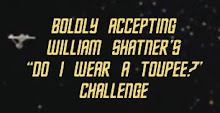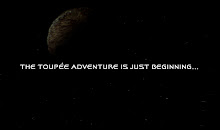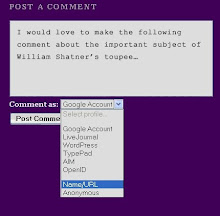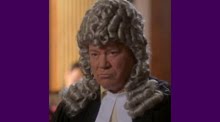 A young William Shatner.
A young William Shatner. is an obscure 1951 Canadian movie that is most famous today as the film in which William Shatner made his first ever screen appearance at a mere twenty years of age. To our knowledge, it is also the only time that the actor was credited on-screen as "Bill Shatner" rather than "William Shatner".

The film stars Paul Colbert as Roger LaRoche, Mary Lou Hennessey as Mary, Eric Workman as "the father" and
Peter Sturgess as "the butler" - no character names are used in the credits, only in the story itself. Bill Shatner plays a nameless crook.
Now we'll
try to tell you a little about the plot. Try? We think you'll see what we mean:

LaRoche is a social worker who runs a boy's club; he dreams of being able to raise the money to build the children a summer camp. His girlfriend, Hennessey, tells him that she has persuaded her rich uncle - who she reveals is actually her father - to finance the camp.

Meanwhile, Hennessey's very nosy butler is on his night off. He's been tracking the above events. We then follow a mysterious group of crooks (one of them played by Bill Shatner) who break into a clothes shop and kill the owner.

Turns out they've been hired by a businessman who wants to bump off his partner. They dump the body:
The butler has been watching this unfold too.

An excited LaRoche and his girlfriend tell the children that their dream of a summer camp will soon become a reality.

It's time to meet the father.

But the butler is convinced the man is a gold-digger and persuades his (scarily protective) boss of the same.

When LaRoche comes over to pick up his check, he discovers that it hasn't been signed.

The old man has no intention of giving him any money.
The girlfriend, undaunted by any of this, instead persuades her boyfriend to take some money she has in a safe. She simply insists that he have it! Mary tells the butler to have another night off so LaRoche won't be disturbed while he breaks into the safe.
The butler then returns to the location where he saw the body being dumped and for some reason takes the body home. This at the same time that LaRoche is at the house accessing the safe.

So now there's a dead body in the house and everyone will think that LaRoche did it! The butler begins to feel bad about his meddling.

The goons come back and see that the body they dumped is missing - they now need it now for proof they carried out their hit.
They remember seeing the butler in the area and track him down to the family mansion. As they arrive, LaRoche runs out of the mansion; the goons think it's the butler and kidnap him.

The butler then goes to a bar and finds out from some loose-lipped woman where the goons have taken LaRoche.

He then turns up at the hideout where the goons have LaRoche...

...and rescues the prisoner through the clever use of fire.

A car chase ensues...

The butler and LaRoche drive to the boy's club where the kids help beat up the goons.

It all ends with a giant pillow fight.

The happy couple kiss...

...and the father and finally abandons his suspicion of LaRoche and decides to fund the club after all.

What adventure will the butler have next?

Confused? So were we.
All of this may have the makings of a classic
farce. But the problem is that the tone of the movie is as far from farce as can be. Dead serious, romantic, earnest - rather like a
Frank Capra movie. Completely inappropriate given the events taking place on screen. This makes the whole film feel head-scratchingly ridiculous and woefully misjudged.
There's far, far, far too much plot to cram into such a relatively short feature film. It's a convoluted affair that really stretches any semblance of believability or credibility far beyond breaking point. Is it all entertaining, though? Not really. A farce filmed as a low budget film noir is not really the best recipe for success, we think. The actors perform well enough, the cinematography, dialog, music and other elements are also decent enough - but the overwrought story and the misjudged tone are simply impossible to overcome.

Let's move swiftly to the hair...
We've previously examined toup-less performances from the mid 1950s, but in those, efforts to combat thinning were
already evident. Here, not only is there no toup, but also no thickening, styling or special combing. It's a unique performance in which toupological considerations are entirely non-existent. It's all real! That in itself is remarkable for anyone seeking to study how such issues may have affected Bill Shatner as an actor.

Notably, Bill Shatner's real hair is somewhat different from the "Jim Kirk lace" - the first major toupee choice that he made. The real hair is fluffier and finer; the young actor's naturally curly hair cut quite short and straightened out (this was common during this era).
 Bill Shatner in 1947 - his real hair was curly. More here.
Bill Shatner in 1947 - his real hair was curly. More here. Sadly, Bill Shatner does not have one proper closeup in the entire movie.

As for his performance - it's really too small to rate in any meaningful way. Though, there is evidence of a shifting "gangster" accent and some small hint of the Shatner on-screen madness that we've come to know and love (see the last clip above).

There's also some interesting toupological symbolism in the movie - as if the director somehow knew that this young actor and his many future toupees would one day be famous. The very first major action that Bill Shatner undertakes in the film is to punch what he believes is a person.

It isn't - it's a shirt - an illusion.

Indeed, the entire location is interesting too. He's in a clothing shop surrounded by tailor's dummies. A comment on reality versus illusion?
Near the very end of the film, we also have a curious shot of a boy studying a man's bald head.

The flying detached feathers in the end fight scene - feathers being bird hairs - are also symbolic.
This being the case, it's very possible that director
Roger Racine should be celebrated as a toupological prophet of sorts. Long before even Bill Shatner knew how important the toupee would become, the director was already using symbolism to create subtle yet highly meaningful signs.
Until recently,
The Butler's Night Off was unavailable for viewing by the wider public (the movie wasn't even released commercially after it was completed), only accessible via various film archives. Now, the entire* movie has been made available for on-line viewing at the
Cinemaparlantquebec.ca website - just click
here.
An interesting film that albeit fails because of poor writing and misjudged direction - had there not been a connection to a famous actor, it would quite possibly have been entirely forgotten by now.
 *The site has the movie at a little over 57 mins in length. Imdb.com lists the movie's running time as 74 mins. A mistake on the latter's part? Possibly. However, The Butler's Night Off, as we watched it, does have some rather odd, harsh cuts, so it's also possible that some footage is missing from the Cinemaparlantquebec.ca version. We'll try to get confirmation on this.
*The site has the movie at a little over 57 mins in length. Imdb.com lists the movie's running time as 74 mins. A mistake on the latter's part? Possibly. However, The Butler's Night Off, as we watched it, does have some rather odd, harsh cuts, so it's also possible that some footage is missing from the Cinemaparlantquebec.ca version. We'll try to get confirmation on this.







































































